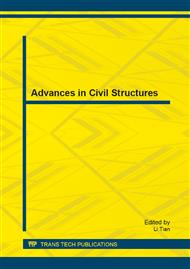p.838
p.845
p.849
p.854
p.860
p.865
p.869
p.875
p.881
Numerical Simulation of Bond Behavior for Adhesive Anchor in Steel-to-Concrete Connection Exposed to Fire
Abstract:
Adhesive anchor is an effective tool for a steel-to-concrete connection combined with the way of post-installed anchorage. However the bond strength of adhesive will decrease at elevated temperature which has a negative effect on anchorage behavior. In this paper a numerical analysis with 3D FE model has been carried out to investigate the tensile performance of adhesive anchor in a steel-to-concrete connection subjected to fire and the results show that high temperature have significant impact on bond strength of anchor even with the protection of fire resisting coating covering the surface of concrete base and the bond stress does not distribute along anchor length during the process of heating. The tensile strength of adhesive anchor presents a great reduction at elevated temperature compared with the strength in normal temperature.
Info:
Periodical:
Pages:
860-864
Citation:
Online since:
August 2013
Authors:
Price:
Сopyright:
© 2013 Trans Tech Publications Ltd. All Rights Reserved
Share:
Citation:


